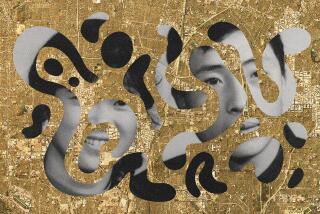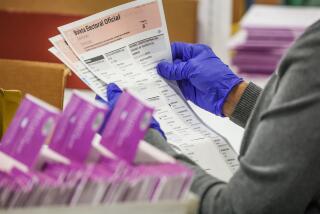Southeast to Be Site of Test to Minimize Miscounting of Minorities by U.S. Census
The U.S. Census Bureau is coming to town a few years early in 21 communities in southeast Los Angeles County and the San Gabriel Valley--communities that, because of their high minority populations and housing density, have been tough to poll in the last two censuses.
Although census takers will not set up shop until October and are to begin mailing questionnaires in March, 1986, bureau officials already have met with local officials to coordinate the census.
Dubbed the Central Los Angeles County Pretest, the experimental census will try to determine the best ways of counting not only Los Angeles County residents but urban dwellers and members of minority groups in general.
Making an accurate count is imperative, because census data determines representation in Congress, and federal, state and county agencies also use the data as one basis for distributing aid money.
Impact Uncertain
It is more difficult for the Census Bureau to count minorities than it is to count the general population, bureau officials said, and the problem is compounded in urban areas.
But even if the census found these missing people, experts interviewed differ on what impact a more accurate census would have on how government aid is distributed, or how it might affect lawmakers who represent the test area in Washington or Sacramento.
Bureau officials chose Los Angeles County as a test area for 1986 because it has a high minority population and is urban and densely populated, said Peter Bounpane, assistant director for demographic censuses at the bureauâs headquarters in Maryland.
Despite difficulties in finding some people, under-counting is not widespread. The Census Bureau estimates it misses only one-half of 1% of the total American population every 10 years.
âThe problem is that even though itâs a small total of the population, it represents the minority population,â said Mike Flanagan, census coordinator at the bureauâs Los Angeles office.
In fact, the bureau estimates that in the 1980 Census, it missed 2% to 4% of the minority population alone. For Latinos, the estimated âmiss rateâ in 1980--the first time the bureau counted Latinos as a subgroup--was 4.5%; for blacks, it was 5.5%, lower than the black miss rate in the 1970 Census.
âThe guess is that there are people in the minority population who for one reason or another fear putting their name on the Census form,â Bounpane said.
Fear of Discovery
He said some members of minority groups may fear losing welfare benefits, or, especially among Latinos, may fear that the information will be turned over to the U.S. Immigration and Naturalization Service in its search for illegal aliens.
âAll these are unfounded, but people do fear that,â he said.
Even legal or naturalized residents sometimes refuse to return the census form, said John Huerta, associate counsel for the Mexican-American Legal Defense and Education Fund.
âThey have so much at stake in staying in this country, they just donât want to rock the boat,â he said, adding legal residents may be fearful because, although they are in the country legally, they still can be deported.
Housing conditions in densely populated urban areas also make polling difficult. Multiple families packed into a dwelling often try to conceal themselves because they fear they are violating zoning or health codes.
But these people, as well as illegal aliens, have nothing to fear, bureau officials said, because the bureau does not release information on individuals, only on averages for each census tract.
Tries to Overcome Concern
The fears exist, though, and the bureau, one official said, is âconstantly trying to overcome them.â One of the purposes of the pretest is to convince people to trust the census.
The actual nationwide Census will not be conducted until 1990. A census is held every 10 years, as mandated by the Constitution.
Censuses are conducted by first determining an areaâs addresses, which are plotted into census tracts. Questionnaires are mailed to the occupant of each address. Residents send the questionnaires back to the bureau office. The bureau then sends pollsters to the addresses that did not respond.
The experimental census will test polling procedures. To establish itself in the test communities, the bureau will open three offices in the area. Instead of trying to get the word out themselves, and to build more trust between the bureau and the community, census takers will ask community groups and leaders to encourage residents to respond to the census.
âAlmost the entire work force will be local people,â Flanagan said.
To cover part of the cost of the pretest, the bureau will spend about $1 million on salaries, services and supplies for the local offices, and expects to hire more than 1,000 workers, census officials said. No census official could give a complete cost for the pretest.
There is more at stake in the census than just successfully gathering information. For example, the federal government uses census data in its revenue-sharing program with the states. Federal agencies distribute the money based on a stateâs population. States, in turn, distribute money to counties and cities based on their populations.
In California, counties rely on state bail-out money and cities rely on state gas tax and vehicle in-lieu funds for revenue. Many of these funds are distributed according to population.
Cities Would Lose Money
While local officials and political observers were uncertain about the degree of under-counting, there is a consensus that if the under-count has been significant, local areas have lost money they should have received.
Residents who are not counted âdonât receive the benefits but they do put into the tax system,â said Geneva Vega, administrative assistant to Assemblywoman Gloria Molina (D-Los Angeles). Molinaâs 56th District includes some of the areas to be polled.
Byron Woosley, city administrator for Bell, one of the targets of the test census, said he has heard ârumblings that the census counts are low in this area, but I canât back that up with any facts. I canât be sure.â
Disputes over population figures can become emotional. New York City claimed that the 1980 Census missed nearly 700,000 residents and successfully sued the bureau to have the figures upgraded. An appeals court reversed the decision, and both parties are awaiting the outcome of a second trial.
When 1980 Census figures came out, officials in Maywood, another target city for 1986, thought the population increase the bureau reported--5,000 people since 1970--was slightly low.
âActually, we thought that we were adding more people here (than the census showed), but we think that there were some families of illegal aliens living here who were afraid to answerâ the census, said Ron Lindsey, director of building and planning for Maywood.
But Lindsey said that even if the population figures are wrong, the city hasnât suffered because of it. The money coming from a more accurate count, he said, would only be âa bonusâ to the city, not a rescue package.
The critical effect of an inaccurate census in densely populated Maywood is not in reducing funds to pay for city services, but in making planning difficult, he said.
Accurate numbers are vital to planning. A cityâs water and sewer systems--its infrastructure--are designed to accommodate a certain number of people. Before a city can add more housing, it must have an accurate census to determine how much more housing it needs and if its infrastructure can handle the increase.
Just as political observers are uncertain about the amount of funds lost because of under-counting, they are unsure about whether an accurate count would increase the political representation of minorities.
William Lammers, professor of political science at USC, said if the census found more people living in the test area than previously thought to be there, it would make a difference only if legislators were to suddenly draw new districts that didnât protect incumbents. He said he does not think that sort of reapportionment is likely.
Nevertheless, because congressional districts can have a maximum of about 500,000 people, if the census finds more people in the target areas, the districts might have to be rearranged. That could cause a ripple effect that could throw out incumbents or a party in districts in other parts of the county, he said.
âThere is a possibility that if you had one or two ripples, that the Democrats might gain, say, (Rep.) Bobbi Fiedlerâs seat in the (San Fernando) Valley,â he said. âBut to get that effect youâd have to have a couple of ripples.â
Leroy Hardy, professor of political science at Cal State Long Beach, said that even if districts are drawn that do not protect incumbents, representation of minorities probably would not increase. Though the population has increased in the Southeast area and San Gabriel Valley, Los Angeles County as a whole has not grown and is not entitled to additional representation.
Hardy said it is more likely that areas of the state outside of Los Angeles County, such as Riverside and San Bernardino counties, would gain if there are increases in representation to the state or national governments.
Miss Rate Disputed
Huerta, the associate counsel for the Mexican-American legal defense fund, disputes the accuracy of the Census Bureauâs 4.5% miss rate for Latinos. It âcould be quite a bit higherâ because the bureau hasnât taken into account increased immigration from Central America, he said. While growth overall in Los Angeles County is stable, he said, the minority population has increased while the white population has declined.
In 1981, Hardy helped a legislative committee redraw district lines in Los Angeles County. The reapportionment created three new congressional districts with populations that were predominantly Latino, and the result was increased Latino political power, he said.
âEven if we find an additional 100,000 people, or even 200,000,â Hardy said, âthereâs only going to be enough population for three Hispanic congressional districts.â
An increase in the sheer number of minority residents might not make a difference âunless the minority groups participate (in politics) at a higher level than they do right now,â he said.
The bureau will conduct the census in Bell, Bell Gardens, Commerce, Compton, Cudahy, east Compton, East Los Angeles, Florence-Graham, Huntington Park, Lynwood, Maywood, Montebello, Monterey Park, Pico Rivera, South El Monte, South Gate, South San Gabriel, Walnut Park, west Compton, west Whittier-Los Nietos and Willowbrook.
More to Read
Sign up for Essential California
The most important California stories and recommendations in your inbox every morning.
You may occasionally receive promotional content from the Los Angeles Times.





![[20060326 (LA/A20) -- STATING THE CASE: Marchers organized by unions, religious organizations and immigrants rights groups carry signs and chant in downtown L.A. "People are really upset that all the work they do, everything that they give to this nation, is ignored," said Angelica Salas of the Coalition of Humane Immigrant Rights. -- PHOTOGRAPHER: Photographs by Gina Ferazzi The Los Angeles Times] *** [Ferazzi, Gina -- - 109170.ME.0325.rights.12.GMF- Gina Ferazzi/Los Angeles Times - Thousands of protesters march to city hall in downtown Los Angeles Saturday, March 25, 2006. They are protesting against House-passed HR 4437, an anti-immigration bill that opponents say will criminalize millions of immigrant families and anyone who comes into contact with them.]](https://ca-times.brightspotcdn.com/dims4/default/34f403d/2147483647/strip/true/crop/1983x1322+109+0/resize/840x560!/quality/75/?url=https%3A%2F%2Fcalifornia-times-brightspot.s3.amazonaws.com%2Fzbk%2Fdamlat_images%2FLA%2FLA_PHOTO_ARCHIVE%2FSDOCS%2854%29%2Fkx3lslnc.JPG)




